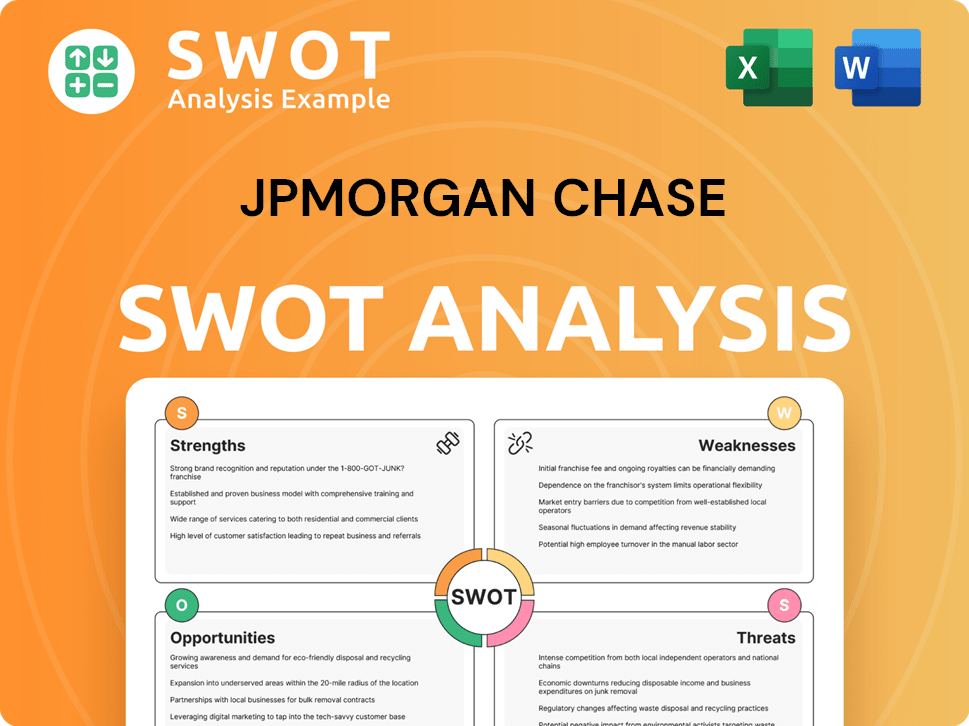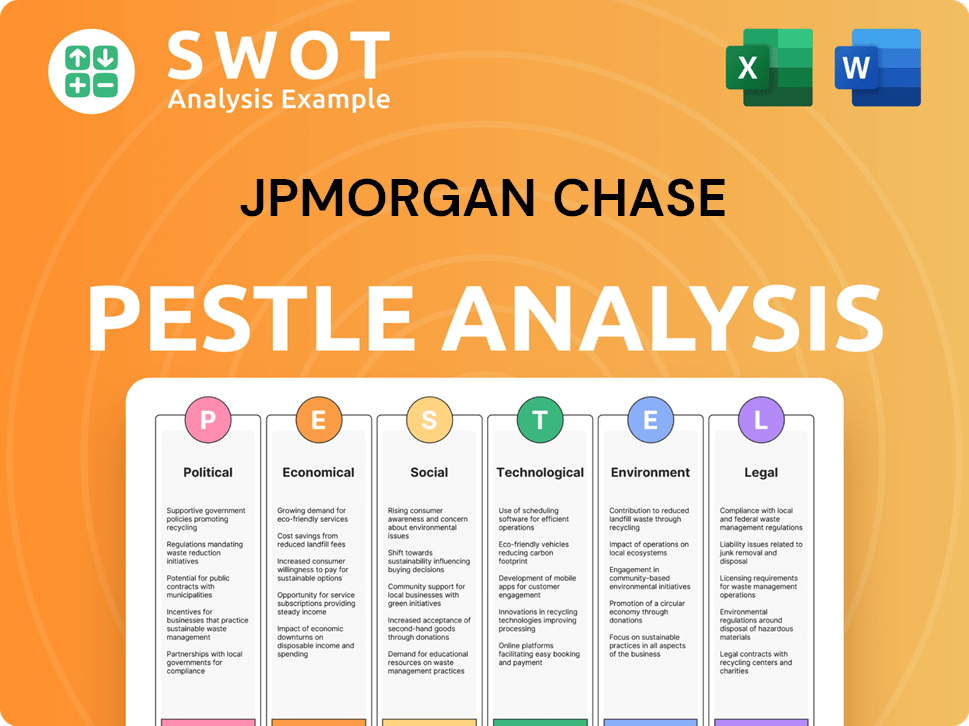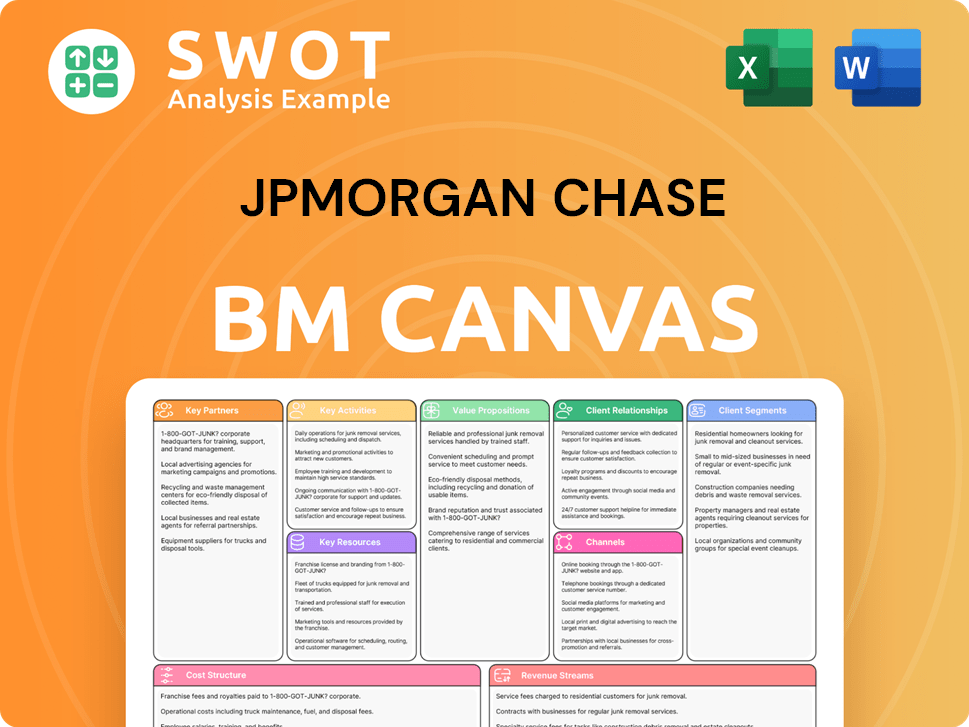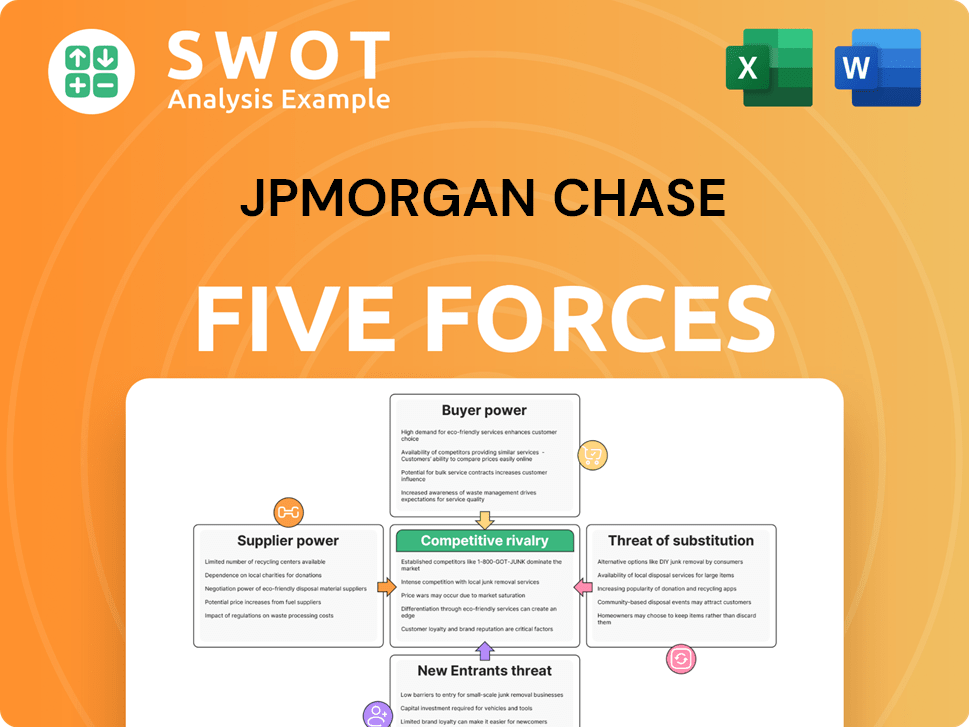JPMorgan Chase Bundle
Who Are JPMorgan Chase's Ideal Customers?
Delving into the world of JPMorgan Chase SWOT Analysis unveils the critical importance of understanding its customer base. What are the customer demographics that drive this financial powerhouse? Uncover the JPMorgan Chase target market and how this influences its strategic decisions.

The banking industry analysis highlights the need for financial institutions to know their customers. This includes a deep dive into JPMorgan Chase customer age demographics, JPMorgan Chase income levels of customers, and JPMorgan Chase geographic target market. Understanding these elements is crucial for effective market segmentation and tailoring services to meet the evolving needs of financial services customers.
Who Are JPMorgan Chase’s Main Customers?
Understanding the primary customer segments is crucial for analyzing the operations and market position of JPMorgan Chase. The company serves a diverse clientele, encompassing both individual consumers and businesses of varying sizes. This broad customer base allows JPMorgan Chase to offer a wide range of financial services, catering to different needs and financial profiles.
The customer demographics of JPMorgan Chase span all age groups and income levels, from young adults to retirees, and from those with modest incomes to high-net-worth individuals. This wide reach is a key factor in the company's success. JPMorgan Chase's ability to serve such a diverse group highlights its adaptability and comprehensive service offerings within the Revenue Streams & Business Model of JPMorgan Chase.
The company's market segmentation strategy is designed to address the specific needs of each customer group, ensuring that its products and services are relevant and effective. This approach is vital for maintaining customer satisfaction and driving business growth.
The CCB segment serves nearly 80 million consumers and almost 6 million small businesses in the U.S. The customer base includes a significant portion of Millennials and Generation Z, with two-thirds of new accounts in the consumer bank and branded new card segments held by these younger demographics. In 2024, the bank saw nearly 2 million net new checking accounts opened, indicating strong customer acquisition.
This segment focuses on small and mid-sized businesses. JPMorgan Chase provides financial solutions tailored to their specific needs, supporting their growth and operations. The bank offers various services, including loans, deposit accounts, and treasury services, to help these businesses manage their finances effectively.
The CIB segment serves prominent corporate, institutional, and government clients globally. In Q4 2024, the CIB segment's net income rose 59% year-over-year to $6.6 billion, with Investment Banking fees up 49%. This segment provides a wide array of services, including investment banking, market-making, and securities services, catering to the complex financial needs of large organizations.
This segment serves high-net-worth individuals and institutional clients, offering wealth management, asset management, and related services. In Q4 2024, the AWM segment reported a net income of $1.5 billion, up 25% year-over-year, driven by higher management fees and strong net inflows. The focus is on providing personalized financial solutions and investment strategies to meet the specific goals of these clients.
JPMorgan Chase's customer base is segmented across various dimensions, including age, income, and business size. The company's market segmentation strategy is designed to address the specific needs of each customer group. This approach enables JPMorgan Chase to offer tailored products and services, enhancing customer satisfaction and driving business growth. The bank aims to increase its share of U.S. retail deposits from 11.3% at the end of 2024 to a long-term goal of 15%.
- Age: Millennials and Generation Z are a significant focus, with a large percentage of new accounts held by these younger demographics.
- Income: Services cater to individuals across various income levels, from those with modest incomes to high-net-worth individuals.
- Business Size: Services are provided to small and mid-sized businesses, as well as large corporate, institutional, and government clients globally.
- Geographic Target Market: Primarily in the U.S., with significant global operations.
JPMorgan Chase SWOT Analysis
- Complete SWOT Breakdown
- Fully Customizable
- Editable in Excel & Word
- Professional Formatting
- Investor-Ready Format

What Do JPMorgan Chase’s Customers Want?
Understanding the customer needs and preferences is crucial for JPMorgan Chase to maintain its market position and tailor its services effectively. The company's approach is heavily influenced by the evolving behaviors of its diverse customer base. This includes a deep dive into customer demographics and their specific financial needs.
A key trend is the increasing preference for digital banking solutions. Customers seek convenience and accessibility, with mobile apps playing a central role in their financial management. This shift drives JPMorgan Chase to continuously enhance its digital offerings and customer experience.
JPMorgan Chase's customers are driven by a range of financial needs, motivations, and preferences that influence their banking choices. A significant trend is the increasing reliance on digital banking, with a February 2024 survey by Chase revealing that 62% of consumers cannot live without their mobile banking app, and 78% use it weekly.
The reliance on digital banking is substantial. Convenience and accessibility are key drivers. Mobile apps are used frequently for managing finances.
Customers seek tools for financial health. Interest in credit monitoring and score improvement is high. Younger generations are particularly interested in these tools.
Customers want integrated financial solutions. They prefer using a single app for all banking needs. This includes travel, entertainment, and loan management.
Personalized experiences are valued by customers. Data-driven engagement and relevant offers are important. The goal is to streamline financial management.
JPMorgan Chase uses data to understand customer behavior. This helps in providing tailored offers. They aim to address customer pain points effectively.
The bank focuses on strategies for customer acquisition. It also emphasizes customer retention strategies. Understanding customer needs is key to both.
JPMorgan Chase tailors its offerings and marketing to these preferences. For instance, its Chase Media Solutions, launched in April 2024, connects customers with retail deals tailored to their spending habits directly through the bank app. This demonstrates an understanding of personalized experiences and data-driven engagement, addressing customer pain points by providing relevant offers and streamlining financial management. This approach helps in customer acquisition strategies and customer retention strategies. To further understand the competitive landscape, consider the Competitors Landscape of JPMorgan Chase.
Customers prioritize convenience, accessibility, and financial health tools. They prefer integrated solutions and personalized experiences. Data-driven engagement is crucial for meeting customer needs and wants.
- Digital Banking: High usage of mobile apps for managing finances.
- Financial Health Tools: Interest in credit monitoring and budgeting.
- Integrated Solutions: Preference for a single app for various financial needs.
- Personalized Offers: Tailored deals based on spending habits.
- Data-Driven Engagement: Using data to understand customer behavior.
JPMorgan Chase PESTLE Analysis
- Covers All 6 PESTLE Categories
- No Research Needed – Save Hours of Work
- Built by Experts, Trusted by Consultants
- Instant Download, Ready to Use
- 100% Editable, Fully Customizable

Where does JPMorgan Chase operate?
The geographical market presence of JPMorgan Chase is extensive, serving millions of customers across the United States and numerous countries worldwide. The company's strategic approach to market segmentation and customer demographics is evident in its widespread operations and targeted expansion efforts. This includes a strong focus on both domestic and international growth, leveraging its existing infrastructure and brand recognition to capture new markets and deepen its relationships with financial services customers.
In the U.S., JPMorgan Chase maintains a robust physical presence with a vast branch network. The company's strategy includes increasing its coverage within the U.S. population and expanding its reach in smaller cities and towns. This commitment to physical and digital accessibility underscores its goal to serve a broad spectrum of customers and strengthen its position in the banking industry analysis.
Beyond the U.S., JPMorgan Chase has a significant global footprint, offering a wide range of financial products and services. The firm's international strategy involves strategic investments and expansions, such as the planned launch of a digital-first consumer bank in Germany. This move, along with its ongoing investments in the UK, demonstrates its commitment to global growth and its ability to adapt to diverse market needs, aligning with its customer acquisition strategies.
Chase has approximately 5,000 branches across 48 states, covering an estimated 68% of the U.S. population. The company aims to expand this to 75% coverage within an accessible drive time of a Chase branch. In 2024, Chase held an 11.3% national market share in retail deposits, with a long-term goal of 15%.
Plans to launch a digital-first consumer bank in Germany by late 2024 or early 2025. In May 2024, the company committed £40 million to drive inclusive economic growth in the UK. This includes investments to support non-profit organizations and small businesses, enhancing its customer relationship management.
JPMorgan Chase is focused on expanding its market share and enhancing its customer value proposition through strategic initiatives. The company aims to increase its share of the nation's spending on its credit cards from 17% to 20%. The firm's investments in digital banking and international expansion are designed to capture a broader customer base and improve customer satisfaction surveys. For more insights, explore the Growth Strategy of JPMorgan Chase.
- The company is targeting long-term growth in retail deposits and credit card spending.
- Investments in the UK support non-profits and small businesses.
- Expansion into Germany leverages existing corporate banking presence.
- These initiatives are aimed at enhancing JPMorgan Chase's customer needs and wants.
JPMorgan Chase Business Model Canvas
- Complete 9-Block Business Model Canvas
- Effortlessly Communicate Your Business Strategy
- Investor-Ready BMC Format
- 100% Editable and Customizable
- Clear and Structured Layout

How Does JPMorgan Chase Win & Keep Customers?
JPMorgan Chase employs a multifaceted approach to customer acquisition and retention, leveraging a combination of traditional and digital channels. The company's strategy includes expanding its physical branch network and enhancing digital services to attract and retain customers. This approach is supported by significant investments in marketing and technology, focusing on customer experience and personalized services within the competitive banking industry analysis.
The bank actively uses data-driven insights to understand its customer demographics and tailor its offerings. This includes launching platforms like Chase Media Solutions to connect customers with relevant retail deals, improving payment loyalty. JPMorgan Chase's commitment to digital innovation and customer-centric strategies is evident in its efforts to provide financial health tools and personalized services, especially for specific segments of the JPMorgan Chase target market.
The primary focus is on creating a seamless customer experience that meets the diverse needs of its customer base. This involves offering valuable products and services, such as personalized financial advice, and investing in technology to improve customer interactions. The company's strategies are designed to maintain and grow its customer base by focusing on customer satisfaction and long-term relationships.
JPMorgan Chase is expanding its physical presence by opening new bank branches. The company plans to open over 500 new branches in the next three years. This expansion strategy is particularly focused on increasing its presence in key markets.
Digital channels play a crucial role in customer acquisition and engagement. The Chase mobile app saw a 10% increase in users in 2023, reaching 54 million customers. Digital tools for financial health are also key.
The bank uses customer data and segmentation to target campaigns. Chase Media Solutions connects 80 million customers with tailored retail deals. This strategy enhances payment loyalty and creates new revenue streams.
J.P. Morgan Financial Centers are being opened to provide personalized services for affluent clients. 14 new centers were opened in May 2025. These centers cater to clients with over $750,000 in qualifying deposit and investment balances.
JPMorgan Chase's customer acquisition and retention strategies are designed to attract, engage, and retain a diverse customer base. These strategies include a mix of physical expansion, digital innovation, and personalized services. This approach is supported by significant investments in marketing and technology, focusing on customer experience and tailored solutions. For more insights, see Owners & Shareholders of JPMorgan Chase.
- Physical Expansion: Opening new branches to increase market presence and accessibility.
- Digital Innovation: Enhancing mobile app features and introducing platforms like Chase Media Solutions.
- Personalized Services: Offering tailored deals and financial advice based on customer data.
- Affluent Banking: Providing specialized services through J.P. Morgan Financial Centers.
- Marketing Investment: Spending approximately $4.9 billion in 2024 to attract and engage customers.
JPMorgan Chase Porter's Five Forces Analysis
- Covers All 5 Competitive Forces in Detail
- Structured for Consultants, Students, and Founders
- 100% Editable in Microsoft Word & Excel
- Instant Digital Download – Use Immediately
- Compatible with Mac & PC – Fully Unlocked

Related Blogs
- What are Mission Vision & Core Values of JPMorgan Chase Company?
- What is Competitive Landscape of JPMorgan Chase Company?
- What is Growth Strategy and Future Prospects of JPMorgan Chase Company?
- How Does JPMorgan Chase Company Work?
- What is Sales and Marketing Strategy of JPMorgan Chase Company?
- What is Brief History of JPMorgan Chase Company?
- Who Owns JPMorgan Chase Company?
Disclaimer
All information, articles, and product details provided on this website are for general informational and educational purposes only. We do not claim any ownership over, nor do we intend to infringe upon, any trademarks, copyrights, logos, brand names, or other intellectual property mentioned or depicted on this site. Such intellectual property remains the property of its respective owners, and any references here are made solely for identification or informational purposes, without implying any affiliation, endorsement, or partnership.
We make no representations or warranties, express or implied, regarding the accuracy, completeness, or suitability of any content or products presented. Nothing on this website should be construed as legal, tax, investment, financial, medical, or other professional advice. In addition, no part of this site—including articles or product references—constitutes a solicitation, recommendation, endorsement, advertisement, or offer to buy or sell any securities, franchises, or other financial instruments, particularly in jurisdictions where such activity would be unlawful.
All content is of a general nature and may not address the specific circumstances of any individual or entity. It is not a substitute for professional advice or services. Any actions you take based on the information provided here are strictly at your own risk. You accept full responsibility for any decisions or outcomes arising from your use of this website and agree to release us from any liability in connection with your use of, or reliance upon, the content or products found herein.